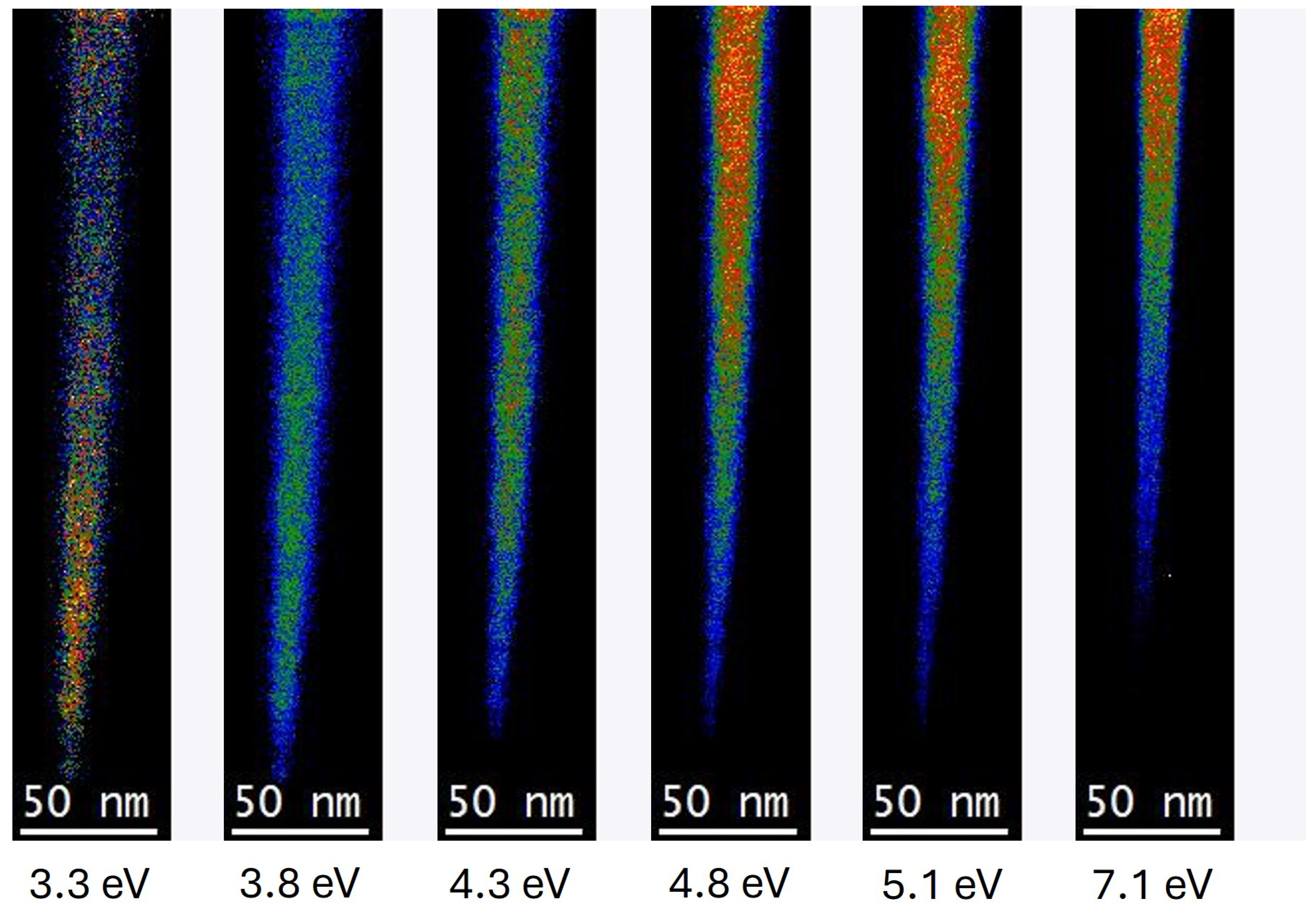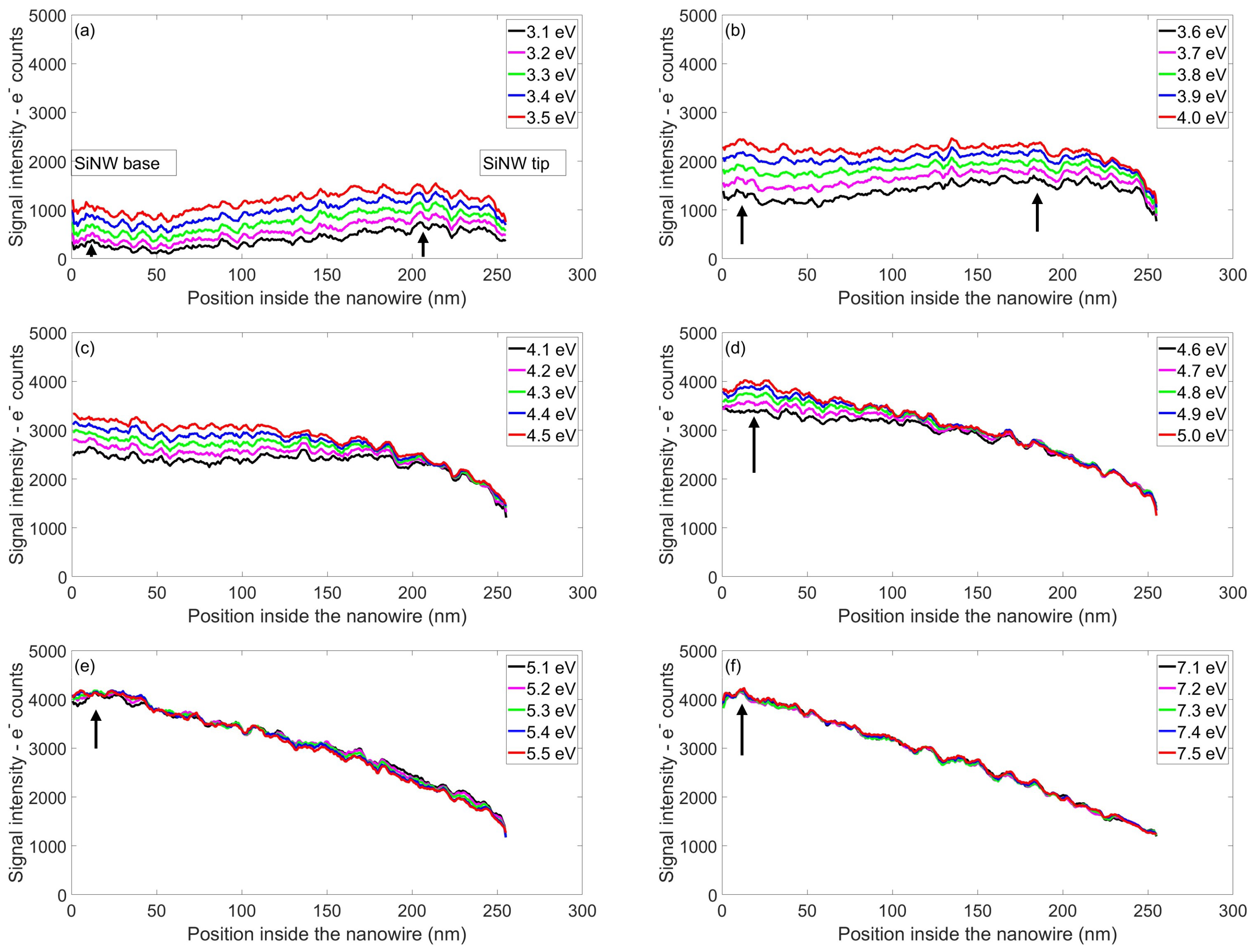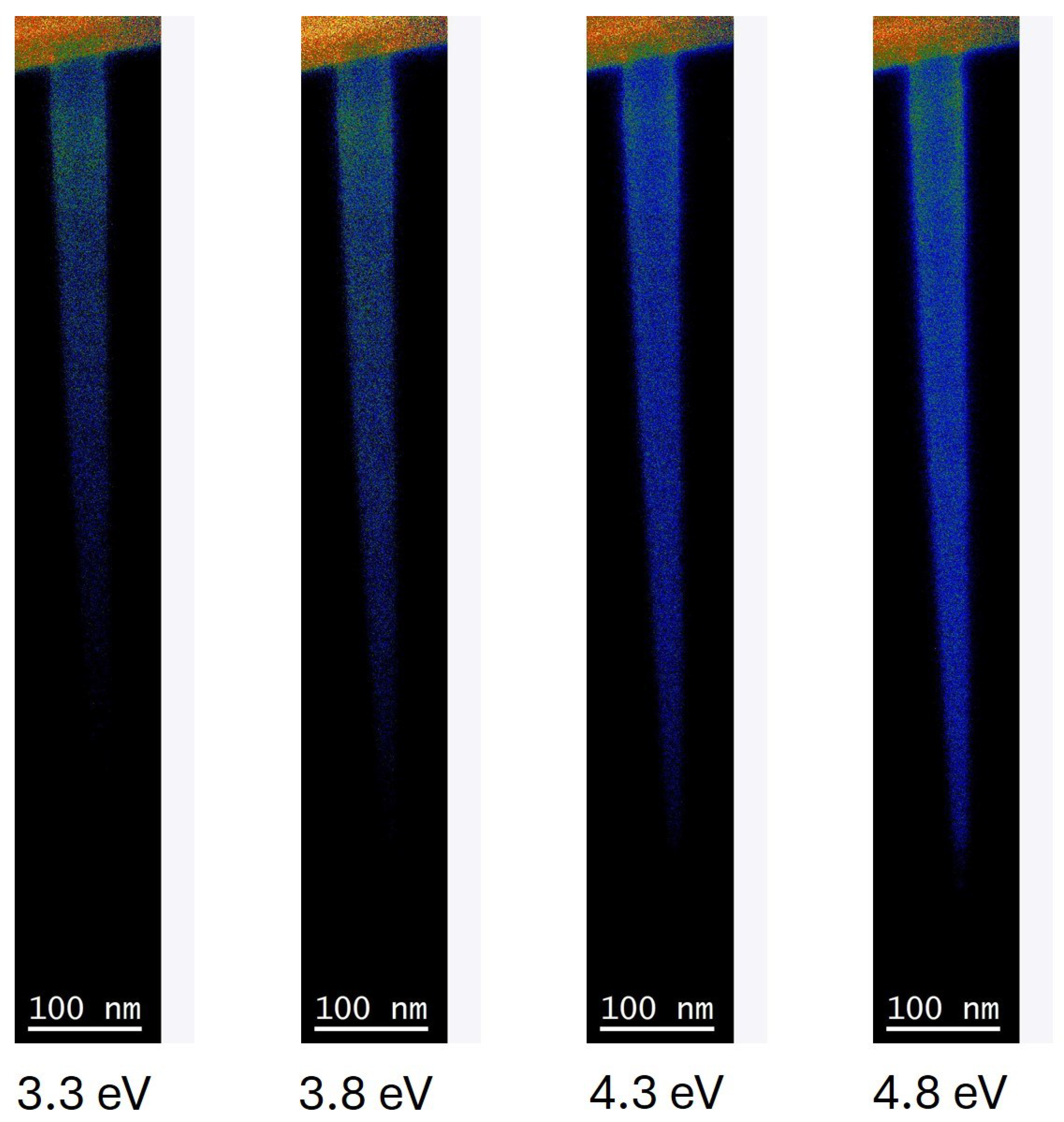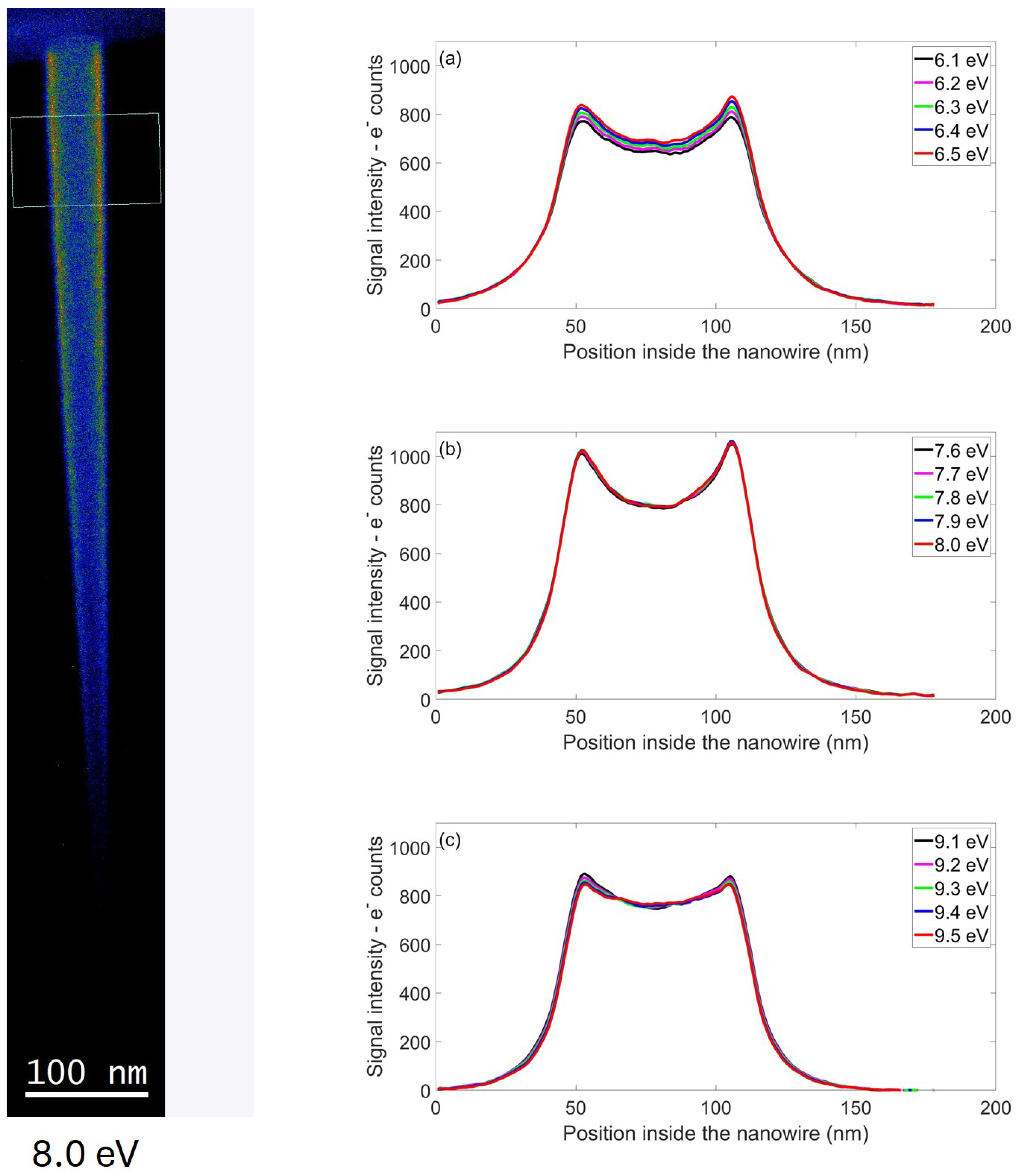Plasmon Response in Individual Conical Silicon Nanowires with Different Lengths
Abstract
1. Introduction
2. Methods
3. Results and Discussion
4. Conclusions
Supplementary Materials
Author Contributions
Funding
Data Availability Statement
Conflicts of Interest
Abbreviations
| NWs | Semiconductor nanowires |
| SiNWs | Silicon nanowires |
| LPR | Longitudinal plasmon resonance |
| TPR | Transverse plasmon resonance |
| PR | Plasmon resonance |
| EELS | Electron energy loss spectroscopy |
| STEM | Scanning transmission electron microscope |
| SI | Supplementary information |
| EFSI | Energy−filtered spectroscopic images |
References
- Kayes, B.M.; Atwater, H.A.; Lewis, N.S. Comparison of the device physics principles of planar and radial p-n junction nanorod solar cells. J. Appl. Phys. 2005, 97, 114302. [Google Scholar] [CrossRef]
- Stelzner, T.; Pietsch, M.; Andrä, G.; Falk, F.; Ose, E.; Christiansen, S. Silicon nanowire-based solar cells. Nanotechnology 2008, 19, 295203. [Google Scholar] [CrossRef] [PubMed]
- Chen, W.; Roca i Cabarrocas, P. Insights into gold-catalyzed plasma-assisted CVD growth of silicon nanowires. Appl. Phys. Lett. 2016, 109, 043108. [Google Scholar] [CrossRef]
- Kolasinski, K.W. Catalytic growth of nanowires: Vapor–liquid–solid, vapor–solid–solid, solution–liquid–solid and solid–liquid–solid growth. Curr. Opin. Solid State Mater. Sci. 2006, 10, 182–191. [Google Scholar] [CrossRef]
- Garozzo, C.; La Magna, A.; Mannino, G.; Privitera, V.; Scalese, S.; Sberna, P.M.; Simone, F.; Puglisi, R.A. Competition between uncatalyzed and catalyzed growth during the plasma synthesis of Si nanowires and its role on their optical properties. J. Appl. Phys. 2013, 113, 214313. [Google Scholar] [CrossRef]
- Shao, M.; Cheng, L.; Zhang, X.; Ma, D.D.D.; Lee, S.t. Excellent Photocatalysis of HF-Treated Silicon Nanowires. J. Am. Chem. Soc. 2009, 131, 17738–17739. [Google Scholar] [CrossRef]
- McAlpine, M.C.; Ahmad, H.; Wang, D.; Heath, J.R. Highly ordered nanowire arrays on plastic substrates for ultrasensitive flexible chemical sensors. Nat. Mater. 2007, 6, 379–384. [Google Scholar] [CrossRef] [PubMed]
- Pandey, R.R.; Alshahrani, H.S.; Krylyuk, S.; Williams, E.H.; Davydov, A.V.; Chusuei, C.C. Electrochemical Detection of Acetaminophen with Silicon Nanowires. Electroanalysis 2018, 30, 886–891. [Google Scholar] [CrossRef]
- Moeinian, A.; Gür, F.N.; Gonzalez-Torres, J.; Zhou, L.; Murugesan, V.D.; Dashtestani, A.D.; Guo, H.; Schmidt, T.L.; Strehle, S. Highly Localized SERS Measurements Using Single Silicon Nanowires Decorated with DNA Origami-Based SERS Probe. Nano Lett. 2019, 19, 1061–1066. [Google Scholar] [CrossRef]
- Banerjee, D.; Guo, X.; Cloutier, S.G. Plasmon-Enhanced Silicon Nanowire Array-Based Hybrid Heterojunction Solar Cells. Solar RRL 2018, 2, 1800007. [Google Scholar] [CrossRef]
- Lo Faro, M.J.; Leonardi, A.A.; D’Andrea, C.; Morganti, D.; Musumeci, P.; Vasi, C.; Priolo, F.; Fazio, B.; Irrera, A. Low cost synthesis of silicon nanowires for photonic applications. J. Mater. Sci. Mater. Electron. 2020, 31, 34–40. [Google Scholar] [CrossRef]
- Cui, Y.; Lieber, C. Functional nanoscale electronic devices assembled using silicon nanowire building blocks. Science 2001, 291, 851–853. [Google Scholar] [CrossRef] [PubMed]
- Shore, K.A. Nanowires: Building blocks for nanoscience and nanotechnology, by A. Zhang, G. Zheng, and C. Lieber. Contemp. Phys. 2017, 58, 294. [Google Scholar] [CrossRef]
- Puglisi, R.A.; Garozzo, C.; Bongiorno, C.; Franco, S.D.; Italia, M.; Mannino, G.; Scalese, S.; Magna, A.L. Molecular doping applied to Si nanowires array based solar cells. Sol. Energy Mater. Sol. Cells 2015, 132, 118–122. [Google Scholar] [CrossRef]
- Li, Y.; Chen, Q.; He, D.; Li, J. Radial junction Si micro/nano-wire array photovoltaics: Recent progress from theoretical investigation to experimental realization. Nano Energy 2014, 7, 10–24. [Google Scholar] [CrossRef]
- Kelzenberg, M.D.; Boettcher, S.W.; Petykiewicz, J.; Turner-Evans, D.B.; Putnam, M.C.; Warren, E.L.; Spurgeon, J.M.; Briggs, R.M.; Lewis, N.S.; Atwater, H.A. Enhanced absorption and carrier collection in Si wire arrays for photovoltaic applications. Nat. Mater. 2010, 9, 239–244. [Google Scholar] [CrossRef]
- Krogstrup, P.; Jorgensen, H.I.; Heiss, M.; Demichel, O.; Holm, J.V.; Aagesen, M.; Nygård, J.; i Morral, A.F. Single-nanowire solar cells beyond the Shockley–Queisser limit. Nat. Photonics 2013, 7, 306–310. [Google Scholar] [CrossRef]
- Han, S.E.; Chen, G. Toward the Lambertian Limit of Light Trapping in Thin Nanostructured Silicon Solar Cells. Nano Lett. 2010, 10, 4692–4696. [Google Scholar] [CrossRef]
- Borgh, G.; Bongiorno, C.; La Magna, A.; Mannino, G.; Patanè, S.; Adam, J.; Puglisi, R.A. Surface Plasmons in Silicon Nanowires. Adv. Photonics Res. 2021, 2, 2100130. [Google Scholar] [CrossRef]
- Borgh, G.; Bongiorno, C.; Magna, A.; Mannino, G.; Shabani, A.; Patanè, S.; Adam, J.; Puglisi, R. Plasmon resonances in silicon nanowires: Geometry effects on the trade-off between dielectric and metallic behaviour. Opt. Mater. Express 2023, 13, 598–609. [Google Scholar] [CrossRef]
- Wu, Y.; Li, G.; Camden, J.P. Probing Nanoparticle Plasmons with Electron Energy Loss Spectroscopy. Chem. Rev. 2018, 118, 2994–3031. [Google Scholar] [CrossRef] [PubMed]
- Rafique, R.; La Magna, A.; Mio, A.; Patanè, S.; Shrivastava, A.; Adam, J.; Puglisi, R.A. Transversal plasmon resonance observed in tapered silicon nanowires. In Proceedings of the 2024 International Conference on Optical MEMS and Nanophotonics (OMN), San Sebastian, Spain, 28 July–1 August 2024; pp. 1–2. [Google Scholar]
- Puglisi, R.A.; Bongiorno, C.; Caccamo, S.; Fazio, E.; Mannino, G.; Neri, F.; Scalese, S.; Spucches, D.; La Magna, A. Chemical Vapor Deposition Growth of Silicon Nanowires with Diameter Smaller Than 5 nm. ACS Omega 2019, 4, 17967–17971. [Google Scholar] [CrossRef] [PubMed]
- Puglisi, R.A.; Bongiorno, C.; Borgh, G.; Fazio, E.; Garozzo, C.; Mannino, G.; Neri, F.; Pellegrino, G.; Scalese, S.; La Magna, A. Study on the Physico-Chemical Properties of the Si Nanowires Surface. Nanomaterials 2019, 9, 818. [Google Scholar] [CrossRef]
- Shir, D.; Liu, B.; Mohammad, A.; Lew, K.; Mohney, S. Oxidation of silicon nanowires. J. Vac. Sci. Technol. Microelectron. Nanometer Struct. 2006, 24, 1333–1336. [Google Scholar] [CrossRef]
- Wagner, R.S.; Ellis, W.C. Vapor-Liquid-Solid mechanism of single crystal growth. Appl. Phys. Lett. 1964, 4, 89–90. [Google Scholar] [CrossRef]
- Putnam, M.C.; Filler, M.A.; Kayes, B.M.; Kelzenberg, M.D.; Guan, Y.; Lewis, N.S.; Eiler, J.M.; Atwater, H.A. Secondary ion mass spectrometry of vapor-liquid-solid grown, Au-catalyzed, Si wires. Nano Lett. 2008, 8 10, 3109–3113. [Google Scholar] [CrossRef]
- Moutanabbir, O.; Senz, S.; Zhang, Z.; Gösele, U. Synthesis of isotopically controlled metal-catalyzed silicon nanowires. Nano Today 2009, 4, 393–398. [Google Scholar] [CrossRef]
- Irrera, A.; Pecora, E.F.; Priolo, F. Control of growth mechanisms and orientation in epitaxial Si nanowires grown by electron beam evaporation. Nanotechnology 2009, 20, 135601. [Google Scholar] [CrossRef]
- Sivakov, V.; Andrä, G.; Himcinschi, C.; Gösele, U.; Zahn, D.R.T.; Christiansen, S.H. Growth peculiarities during vapor–liquid–solid growth of silicon nanowhiskers by electron-beam evaporation. Appl. Phys. A 2006, 85, 311–315. [Google Scholar] [CrossRef]
- Morral, A.F.; Arbiol, J.; Prades, J.D.; Cirera, A.; Morante, J.R. Synthesis of Silicon Nanowires with Wurtzite Crystalline Structure by Using Standard Chemical Vapor Deposition. Adv. Mater. 2007, 19, 1347–1351. [Google Scholar] [CrossRef]
- Dhalluin, F.; Desré, P.J.; den Hertog, M.I.; Rouvière, J.L.; Ferret, P.; Gentile, P.; Baron, T. Critical condition for growth of silicon nanowires. J. Appl. Phys. 2007, 102, 094906. [Google Scholar] [CrossRef]
- Zardo, I.; Conesa-Boj, S.; Estradé, S.; Yu, L.; Peiró, F.; i Cabarrocas, P.R.; Morante, J.R.; Arbiol, J.; Arbiol, J.; i Morral, A.F.; et al. Growth study of indium-catalyzed silicon nanowires by plasma enhanced chemical vapor deposition. Appl. Phys. A 2010, 100, 287–296. [Google Scholar] [CrossRef]
- Ross, F.M.; Tersoff, J.; Reuter, M.C. Sawtooth faceting in silicon nanowires. Phys. Rev. Lett. 2005, 95, 146104. [Google Scholar] [CrossRef] [PubMed]
- Davanco, M.; Srinivasan, K. Hybrid gap modes induced by fiber taper waveguides: Application in spectroscopy of single solid-state emitters deposited on thin films. Opt. Express 2010, 18 11, 10995–11007. [Google Scholar] [CrossRef]






Disclaimer/Publisher’s Note: The statements, opinions and data contained in all publications are solely those of the individual author(s) and contributor(s) and not of MDPI and/or the editor(s). MDPI and/or the editor(s) disclaim responsibility for any injury to people or property resulting from any ideas, methods, instructions or products referred to in the content. |
© 2024 by the authors. Licensee MDPI, Basel, Switzerland. This article is an open access article distributed under the terms and conditions of the Creative Commons Attribution (CC BY) license (https://creativecommons.org/licenses/by/4.0/).
Share and Cite
Rafique, R.; La Magna, A.; Mio, A.M.; Patanè, S.; Adam, J.; Puglisi, R.A. Plasmon Response in Individual Conical Silicon Nanowires with Different Lengths. Photonics 2024, 11, 999. https://doi.org/10.3390/photonics11110999
Rafique R, La Magna A, Mio AM, Patanè S, Adam J, Puglisi RA. Plasmon Response in Individual Conical Silicon Nanowires with Different Lengths. Photonics. 2024; 11(11):999. https://doi.org/10.3390/photonics11110999
Chicago/Turabian StyleRafique, Rizwan, Antonino La Magna, Antonio Massimiliano Mio, Salvatore Patanè, Jost Adam, and Rosaria Anna Puglisi. 2024. "Plasmon Response in Individual Conical Silicon Nanowires with Different Lengths" Photonics 11, no. 11: 999. https://doi.org/10.3390/photonics11110999
APA StyleRafique, R., La Magna, A., Mio, A. M., Patanè, S., Adam, J., & Puglisi, R. A. (2024). Plasmon Response in Individual Conical Silicon Nanowires with Different Lengths. Photonics, 11(11), 999. https://doi.org/10.3390/photonics11110999








